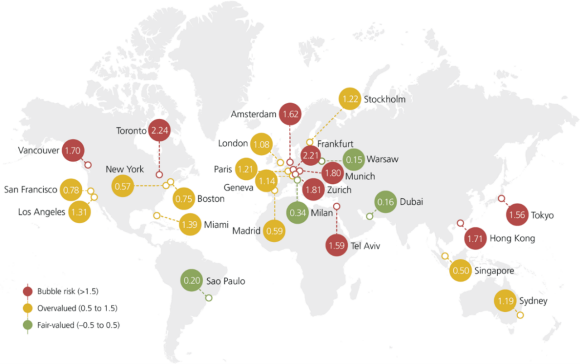Find out more insights

In many cities, there is not enough housing supply. And by its very nature, housing supply cannot be expanded at will in the short term. Thanks to urbanization, this means property prices should rise significantly in the long run – summing up the common narrative on the value growth of urban homes. The strong real estate boom of the last decade underlines this credo once again. However, if urban residential rents are used as a benchmark, the supposed scarcity effect evaporates: rents have only risen hand in hand with local wages over the same period. The main reason for the exorbitant increases in home prices thus lies elsewhere.

Strong house price growth
Nominal house price growth in the cities analyzed accelerated to 10% from mid-2021 to mid-2022, representing the highest increase since 2007. Four US cities—Miami, Los Angeles, San Francisco, and Boston—are among the top five with the fastest-growing prices.
High imbalances in Canada and Europe
Imbalances are sky-high in both analyzed Canadian cities, with Toronto topping the index. Valuations in Frankfurt, Zurich, Munich, and Amsterdam also show elevated risks in Europe. In contrast, there is no bubble risk in the US cities.
Affordability to the fore
Since last year, mortgage rates have almost doubled on average across the cities analyzed. Alongside increased prices, this makes city housing much less affordable. A skilled service sector worker can afford roughly one-third less housing space than before the pandemic.



Household leverage on the rise
In almost all cities, households have been leveraging up. Outstanding mortgages recorded the strongest increase since 2008. Debt-to-GDP is on the rise as well, reflecting the cheap financing conditions and weak economic growth since the pandemic.
Urbanization back on track
People have returned to the cities.
Strong household formation and unaffordable owner-occupied housing drove demand for rental units. As a result, rents grew by 7% on average last year, making up all rental losses accumulated during the first year of pandemic.
Gloomy prospects
Higher interest rates, inflation, turmoil in the financial markets, and deteriorating economic conditions are putting the housing boom under pressure. In a majority of cities with high valuations, price corrections have either already begun, or are expected to start in the coming quarters.

